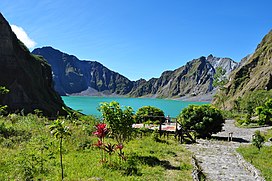Our website is made possible by displaying online advertisements to our visitors.
Please consider supporting us by disabling your ad blocker.
Mount Pinatubo
| Mount Pinatubo | |
|---|---|
 Mount Pinatubo crater lake in 2012 | |
| Highest point | |
| Elevation |
|
| Listing | Active volcanoes in the Philippines |
| Coordinates | 15°08′30″N 120°21′00″E / 15.14167°N 120.35000°E |
| Naming | |
| Language of name | Tagalog |
| Pronunciation | /ˌpiːnəˈtuːboʊ/ |
| Geography | |
 | |
| Location | Luzon |
| Country | Philippines |
| Region | Central Luzon |
| Provinces | |
| Parent range | Zambales Mountains |
| Geology | |
| Rock age(s) | Between 635,000 ± 80,000 and 1.1 ± 0.09 million years[2] |
| Mountain type | Stratovolcano[1] |
| Volcanic arc | Luzon Volcanic Arc |
| Last eruption | November 30, 2021[3] |
| History of the Philippines |
|---|
 |
| Timeline |
|
|
Mount Pinatubo[4] is an active stratovolcano in the Zambales Mountains in Luzon in the Philippines. Located on the tripoint of Zambales, Tarlac and Pampanga provinces,[5][6] most people were unaware of its eruptive history before the pre-eruption volcanic activity in early 1991. Dense forests, which supported a population of several thousand indigenous Aetas, heavily eroded and obscured Pinatubo.
Pinatubo is known for its VEI-6 eruption on June 15, 1991, the second-largest terrestrial eruption of the 20th century after the 1912 eruption of Novarupta in Alaska.[7] The eruption coincided with Typhoon Yunya making landfall in the Philippines, which brought a dangerous mix of ash and rain to nearby towns and cities. Early predictions led to the evacuation of tens of thousands of people, saving many lives. The eruption severely damaged surrounding areas with pyroclastic surges, pyroclastic falls, and later, flooding lahars caused by rainwater re-mobilizing volcanic deposits. This destruction affected infrastructure and altered river systems for years. [7][8] Minor dome-forming eruptions inside the caldera continued from 1992 to 1993.
The 1991 eruption had worldwide effects. It released roughly 10 billion tonnes (1.1×1010 short tons) or 10 km3 (2.4 cu mi) of magma, bringing large amounts of minerals and toxic metals to the surface. It also released 20 million tonnes (22 million short tons) of SO
2. It ejected more particulate into the stratosphere than any eruption since Krakatoa in 1883. In the following months, aerosols formed a global layer of sulfuric acid haze. Global temperatures dropped by about 0.5 °C (0.9 °F) in the years 1991–1993,[9] and ozone depletion temporarily increased significantly.[10]
- ^ "Pinatubo". Global Volcanism Program. Smithsonian Institution. Archived from the original on January 23, 2020. Retrieved January 23, 2020.
- ^ "Pinatubo Volcano". The Philippine Institute of Volcanology and Seismology (PHIVOLCS). Archived from the original on January 29, 2009. Retrieved August 12, 2008.
- ^ "Pinatubo: Eruptive History". Global Volcanism Program. Smithsonian Institution. Retrieved August 31, 2021.
- ^ Sambal: Bakil nin Pinatobo; Kapampangan: Bunduk/Bulkan ning Pinatubu, Bunduk ning Apu Malyari; Pangasinan: Palandey/Bulkan na Pinatubu; Ilocano: Bantay Pinatubo; Tagalog: Bundok/Bulkang Pinatubo IPA: [pɪ.nɐˈtuː.boʔ]
- ^ "Tarlac map". University of Texas in Austin Library. Archived from the original on July 31, 2019. Retrieved August 2, 2011.
- ^ "Report of the Philippine Commission to the President, 1901 Vol. III" Archived November 30, 2016, at the Wayback Machine, pg. 141. Government Printing Office, Washington, 1901.
- ^ a b "The Cataclysmic 1991 Eruption of Mount Pinatubo, Philippines". Archived from the original on August 25, 2013. Retrieved April 9, 2007.
 This article incorporates text from this source, which is in the public domain.
This article incorporates text from this source, which is in the public domain.
- ^ Rodolfo; Umbal; Alonso. "Two Years of Lahars on the Western Flank of Mount Pinatubo: Initiation, Flow Processes, Deposits, and Attendant Geomorphic and Hydraulic Changes". USGS Publications. Archived from the original on March 16, 2012. Retrieved March 7, 2012.
- ^ Stephen Self; Jing-Xia Zhao; Rick E. Holasek; Ronnie C. Torres & Joey McTaggart (1999). "The Atmospheric Impact of the 1991 Mount Pinatubo Eruption". Archived from the original on August 2, 2014. Retrieved July 25, 2014.
- ^ "Mt. Pinatubo's cloud shades global climate". Science News. Archived from the original on January 7, 2012. Retrieved March 7, 2010.
Previous Page Next Page



